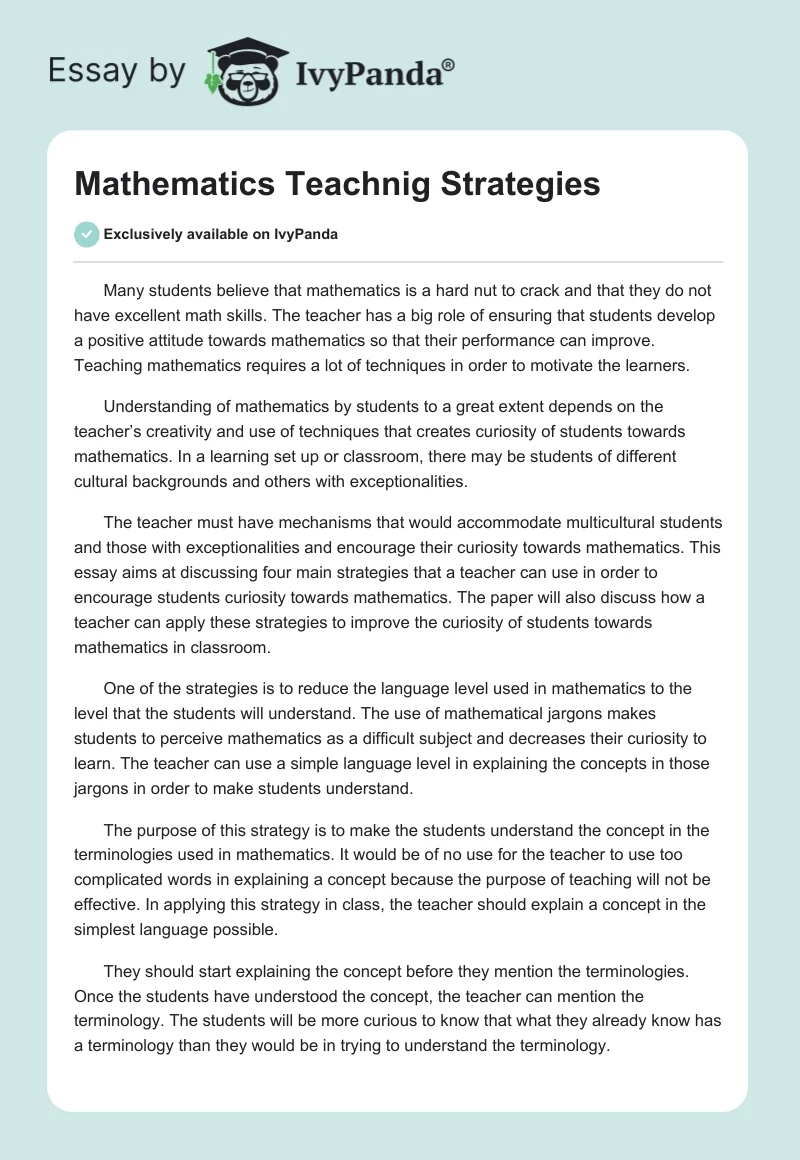Many students believe that mathematics is a hard nut to crack and that they do not have excellent math skills. The teacher has a big role of ensuring that students develop a positive attitude towards mathematics so that their performance can improve. Teaching mathematics requires a lot of techniques in order to motivate the learners.
Understanding of mathematics by students to a great extent depends on the teacher’s creativity and use of techniques that creates curiosity of students towards mathematics. In a learning set up or classroom, there may be students of different cultural backgrounds and others with exceptionalities.
The teacher must have mechanisms that would accommodate multicultural students and those with exceptionalities and encourage their curiosity towards mathematics. This essay aims at discussing four main strategies that a teacher can use in order to encourage students curiosity towards mathematics. The paper will also discuss how a teacher can apply these strategies to improve the curiosity of students towards mathematics in classroom.
One of the strategies is to reduce the language level used in mathematics to the level that the students will understand. The use of mathematical jargons makes students to perceive mathematics as a difficult subject and decreases their curiosity to learn. The teacher can use a simple language level in explaining the concepts in those jargons in order to make students understand.
The purpose of this strategy is to make the students understand the concept in the terminologies used in mathematics. It would be of no use for the teacher to use too complicated words in explaining a concept because the purpose of teaching will not be effective. In applying this strategy in class, the teacher should explain a concept in the simplest language possible.
They should start explaining the concept before they mention the terminologies. Once the students have understood the concept, the teacher can mention the terminology. The students will be more curious to know that what they already know has a terminology than they would be in trying to understand the terminology.
The other strategy is encouraging transfer of knowledge from one student to another. In this strategy, the students are given chances to explain to other what they think is the solution for a certain question. The purpose of this strategy is to enable students learn from each other and also evaluate the work of their classmates, criticize, agree or disagree with them. In so doing, students will be able to air their views and learn the right way of answering questions.
The strategy also makes students more attentive to explanations and increases their curiosity to learn ( McDoniel, 2009, 1). In applying this strategy in class room, the teacher will give questions and ask a student to present the answer on the board as others listen. He may also ask another student repeat the presentation done by another student. All students are encouraged to be attentive during presentation.
The teacher can also use corporate learning strategy. In this case students work in flexible groups and each group will address the needs of the members. This applies in a heterogeneous classroom and it aims at making students more actively involved in their gaining of knowledge and become conscientious for their own learning in a learning set up. The teacher would apply this strategy in classroom by breaking from instructing the whole class and help students form small groups where they work as partners. The teacher pays attention to each group at a time and addresses their needs.
The other strategy that a teacher can use is instruction differentiation. This strategy recognizes that students have different learning abilities and interests. It is aimed at identifying the learning ability of each student and devise instructional strategies that will be effective at all student capacity levels. In classroom, the teacher will apply the strategy by identifying the learning level of each student and come up with instructional strategies that are appropriate for that level.
The teacher will attend to each student according to their learning levels. For instance, he should have time beyond the classroom session to instruct students whose ability could not allow them to understand during the normal class session. This will encourage the students because it will allow slow learners to at least keep pace with the fast learners.
If these strategies could be well applied in the classroom, the curiosity of students towards mathematics could be encouraged and their performance improved.
Reference List
McDoniel, M. (2009). Encouraging Curiosity towards Mathematics: 4 Instructional Strategies. Denver, Colorado: Associated Content, Inc. Web.


